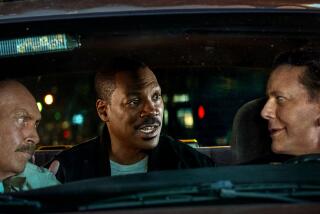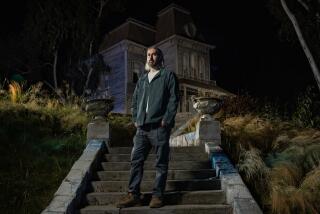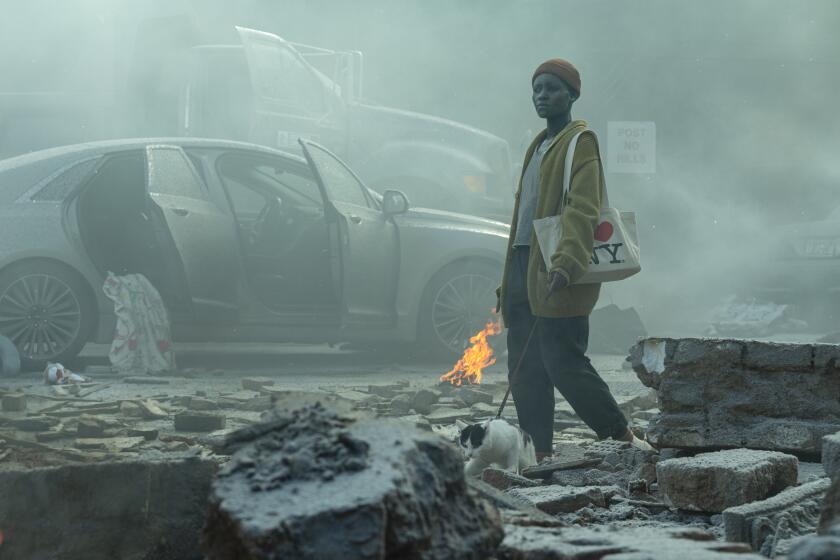Only the Good Die and Return
The current trend of reissuing film classics in theaters will escalate in the wake of the phenomenal “Star Wars” trilogy grosses, as studios busily dust off their libraries for more “special editions” and anniversaries.
A few of the more creative reissues in the works include:
* “The Wizard of Oz” in digital stereo with the complete “If I Only Had a Brain” dance footage directed by Busby Berkeley.
* A 25th anniversary of “The Exorcist” in digital stereo with several missing scenes elaborating on the theme of religious faith.
* The “ultimate director’s cut” of Steven Spielberg’s “Close Encounters of the Third Kind” with digital special effects combining the best of the two previous versions.
* “2001: A Space Odyssey” with digital special effects--plus additional footage of man’s fateful encounter with the monolith on the moon.
“There’s a real good chance we’re going out next year with ‘Oz’ with the scarecrow footage,” suggests Barry Reardon, Warner Bros. president of distribution. “ ‘The Exorcist’ will probably happen next year, and ‘2001’ in ’99 or 2000.
“I’ve told [“2001” director] Stanley [Kubrick] what I want to do, but he has to finish ‘Eyes Wide Shut’ before he can give me a reply. I need to find out if he has the footage taken out.”
Meanwhile, director William Friedkin has consented to reissuing his original cut of “The Exorcist,” but there’s one problem: The footage has yet to be located.
The director says an archivist has been dispatched to search the vaults for the missing four or five scenes.
“None of the stuff that was cut would substantially change the film,” Friedkin admits. “It amounts to about 10 minutes I took out intentionally for pacing--not for a rating. There’s nothing salacious there.
“[Writer-producer William Peter] Blatty feels these missing scenes would enhance the audience’s belief in the ritual,” Friedkin adds. “To me it was obvious the way I shot it. The real benefit will be for film collectors to have another version on laser or DVD.”
Reardon, who has begun cataloging Warner’snewly acquired Turner Entertainment library (MGM, RKO and Warners’ own pre-1948 titles) for future consideration, has immediately taken both “The Wizard of Oz” and “2001” out of distribution to create an event atmosphere.
“With ‘Oz’ and ‘2001’ we can obviously go much wider nationally than the usual 10 to 40 prints for a reissue,” Reardon says. “I really think there’s a core audience out there for classics--and not just on home video. But you have to really push them on your own; you can’t rely on the theaters.”
In addition to these high-profile projects, Warners has more limited plans this fall for “Papillon” and “The Man Who Would Be King.” Other possibilities include revivals of “Cabaret” (25th anniversary) and “Bonnie and Clyde” and “Camelot” (both 30th anniversaries).
Then there’s talk of Warners reissuing “Gone With the Wind” for its 60th anniversary in ’99. Will that need extra footage to sell?
No one realistically expects the “Star Wars” phenomenon to be rivaled--it’s a cultural event all its own.
Yet “Star Wars” has dramatically confirmed what Disney has proven for years: that special classics can play the multiplexes if marketed properly as events.
“I think it’s great that these films are coming out,” says Robert Harris, who performed the highly acclaimed “Vertigo” restoration last year with James Katz. “The studios have to understand what they want to do with them. Are they going to be treated like art-house pictures or first-run events? If you do it right, you can make enough money to justify the expense of the restoration and save the films.”
But most of the studios are still holding back in giving their reissues wider distribution. Paramount, for instance, currently has “The Godfather” reissue in only a handful of theaters. But it released a digitally remastered, widescreen home video edition of the entire trilogy this month to more prominently honor the 25th anniversary of the gangster epic.
The studio is also contemplating two John Travolta reissues to rejuvenate home video sales: a 20th anniversary of “Saturday Night Fever” this year and a 20th anniversary of “Grease” next year.
Even Fox, which has benefited handsomely from the “Star Wars” reissues, is reticent about delving more extensively into its library.
“This is a very expensive proposition,” says Tom Sherak, Fox Domestic Film Group chairman. “You have to have something that makes it special. You have to ask: Does it make sense to see it on the big screen?”
Despite Sherak’s caution, Fox may soon reissue “The King and I” (to coincide with the successful Broadway revival starring Lou Diamond Phillips), depending on the condition of the negative and the expense.
Most experts concede that the reissue trend has been driven by advancements in digital technology as well as the burgeoning home video market (which includes the promising new DVD format).
“Vertigo,” positioned by Universal as both a theatrical and home video event, has sold out its first 250,000 units in a few weeks.
It’s not surprising, then, that these advancements have led to the practice of restoring deleted footage to reissues--which is beginning to stir controversy.
“We’re against using deleted or alternate footage of classics, except on home video,” says Harris. “That’s not restoration--that’s merchandising. And we’re against calling these reissues ‘restorations’--it’s false advertising.”
There are exceptions, such as the director’s cut of Wolfgang Petersen’s “Das Boot” now in theaters with an extra 65 minutes.
“This was a special case where the original creative team was reassembled to put back some of what Wolfgang had used in his miniseries version,” says producer Ortwin Freyermuth. “It’s a different pacing and a different experience for the audience--more of what Wolfgang had in mind but wasn’t allowed to do as a feature.”
Columbia Pictures, the distributor of “Das Boot,” has resisted restoring deleted footage to next year’s reissues of “Funny Girl” and “The Way We Were.” However, both Barbra Streisand films will feature digital stereo sound for their 30th and 25th anniversaries, respectively.
“There was talk of adding a ‘Swan Lake’ ballet sequence to ‘Funny Girl’ and the deleted footage about the Hollywood blacklist to ‘The Way We Were,’ but it’s not going to happen,” says Michael Schlesinger, Columbia’s director of repertory sales.
“Only the picture exists of the ‘Swan Lake’ [and no sound], so we can’t do anything with that theatrically,” Schlesinger adds. “And I asked Sydney Pollack [director of “The Way We Were”] about the missing blacklist footage--and he said he cut it because it wasn’t working. I’m certainly not going to go against his wishes.”
Columbia also has a busy revival schedule for the remainder of the year: “A Man for All Seasons” and “Gilda” (preserved in association with the UCLA Film and Television Archive), the 30th anniversary of “In Cold Blood” and a Frank Capra centennial retrospective.
The most ambitious Columbia reissue, for the 20th anniversary of “Close Encounters of the Third Kind,” originally slated for this year, will probably be pushed back until next year so Spielberg can have sufficient time to clean up the special effects and digitize the sound.
In this regard, the reissue trend has resulted in increased activity at the half a dozen or so film labs that specialize in archival projects.
But the UCLA Film and Television Archive--which pioneered the local preservation field--has found itself now victim of its own success.
“It’s great for the labs, but it’s caused a few frustrations for us in the last couple of years,” says UCLA preservation officer Robert Gitt, who’s currently restoring 45 minutes to the Ingrid Bergman version of “Joan of Arc” in honor of its 50th anniversary next year.
“If we have a funding deadline, the labs have always tried to help us. But the other projects have a longer wait. We’ve become more patient. The important thing is that most of the studios are finally preserving their films after years of neglect.”
More to Read
Only good movies
Get the Indie Focus newsletter, Mark Olsen's weekly guide to the world of cinema.
You may occasionally receive promotional content from the Los Angeles Times.






